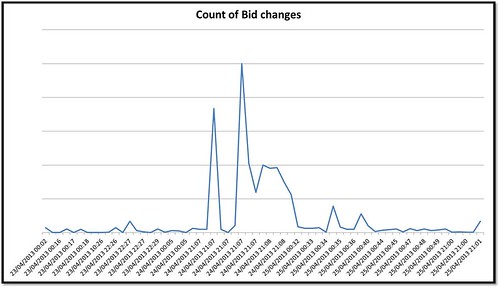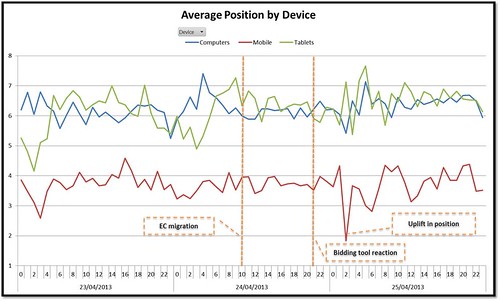To migrate or not to migrate: Do it sooner rather than later and get your house in order!
We still have some smaller accounts to migrate but we would definitely encourage migrating sooner rather than later. This has enabled the team to get to grips with some of the new settings, bidding options and new functionalities e.g. upgraded sitelinks.
One of the biggest things we’ve learnt is that migration turned out to be a very useful account audit/health-check exercise.
When looking at results pre- and post- migration we found, for example, a broad match keyword that was driving a disproportionately high amount of clicks, which didn’t have any negatives attached to it in a tablet-targeted account, so in migrating we actually improved some of our KPI’s which was an unexpected bonus!
We would definitely recommend looking at some KPI’s before and after migration to see if and how they’ve changed, for example:
- Traffic-driving keywords (e.g. top 20/30).
- Split of traffic by device.
- Overall CPC’s (and keyword/device-level).
These will flag any anomalies and will highlight some of the main changes you will face in your results going forward. The good news is that EC accounts are definitely easier to manage which will make ongoing maintenance easier!
The other perceived benefit of migrating sooner than the enforced deadline of July 22nd, is that it’s widely anticipated that CPC’s will rise further after this date as advertisers that weren’t previously in tablet and mobile auctions will be opted in, thus increasing competition.
A rise in CPC’s or a rise in bid changes?: Manage your bid management tools!
On one of our larger accounts, we saw a rise in CPC’s of about 5% post-migration. Aha, I thought –“ I knew EC would cause increased CPC’s!”
However, under closer inspection, it was actually one of our bid management tools that caused an artificial rise. On the day of migration, you can see how many bid changes the tool made compared to a normal day.

It was as if the tool was confused by the fact that all of a sudden the campaigns were opted into the three devices and therefore average position was being calculated based across the three devices instead of individually.
In the graph below we can see that there was an uplift in average position after migration and the subsequent bid changes, particularly accentuated on mobile, which was largely responsible for the increase in CPCs.
We don’t have a full explanation for this bidding behaviour, but it just seemed to us that the tool was a bit confused!

An important learning we made here was to make sure that bid management tools reduced the ‘look-back window’ that they would normally use for optimisation e.g. ignore the last 2 weeks of data and/or use the tools preview mode to double check bid changes before they go live.
So something else to add to your migration checklist:
- Change the settings for your look-back window, and…
- …keep an eye on the amount of bid changes made – you can find this in your AdWords ‘change history’ report).
Once we knew this, and the tool had settled into this new world, then cpc’s seemed to settle back to normal (although marginally higher than they were previously, especially on tablet and mobile).
Now’s the time to test the Alliance
It’s nice to see the Yahoo-Bing Alliance copying Google, but making their version of Enhanced Campaigns even better – on their version of EC, advertisers will be able to opt out of mobile.
This is easier than changing bids down to 0% and makes sense for many advertisers who still have work to do improving their mobile experience. So many companies still don’t use the Alliance for PPC but this new change, coupled with cheaper CPC’s and better targeting options could make this the time to test!
As others have seen, overall we’ve seen mobile and tablet CPCs increase which we expected, but the bid changes and maintenance issues we found along the way were a surprise to us – have you found any other surprises when migrating your accounts?
Comments